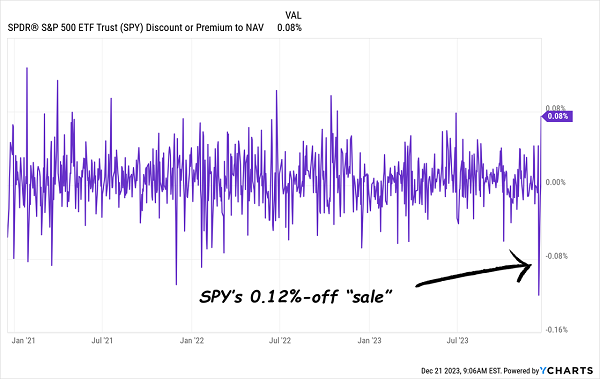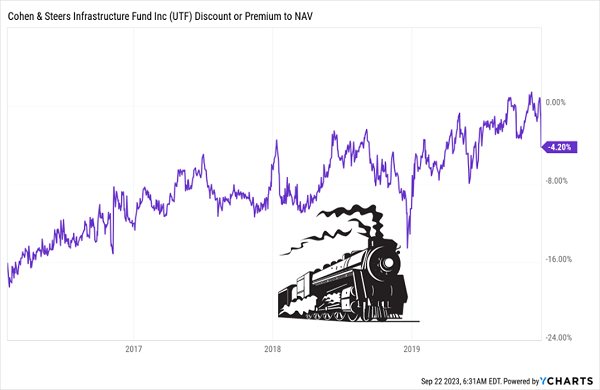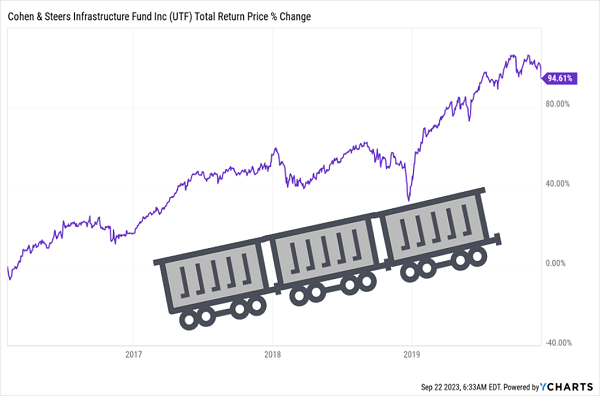If there’s one thing we need to remember when we buy high-yield closed-end funds (CEFs), it’s this: always demand a discount.
Well, make that two: always demand a high dividend, too! Because CEFs are renowned for their high—and often monthly—payouts, with the average CEF yielding around 8% today.
But back to discounts. Luckily for us, they’re common with CEFs: of the 422 CEFs tracked by the CEF Connect screener, 384 trade at discounts to net asset value (NAV).
That’s a great place to start our search for top-notch CEFs, because these discounts are basically free money: they let us pick up, say, Mastercard (MA) for 85 cents on the dollar through a CEF like the Gabelli Dividend & Income Trust (GDV). This fund, run by value-investing guru Mario Gabelli, has Mastercard as its top holding and trades at a 15% discount as I write this.
Another bonus of buying through a CEF is, of course, the aforementioned dividend. Mastercard shares yield just 0.6%. But if you buy through GDV, you’ll get a 6.2% dividend instead—and GDV makes that payout monthly instead of quarterly, like Mastercard.
Discounts to NAV only exist with CEFs. Mutual funds and ETFs issue shares whenever they want, fixed each day at NAV. This is why the popular SPDR S&P 500 ETF Trust (SPY) is never cheap:
SPY’s Biggest Discount Is … 0.12%!?

When It Comes to CEF Discounts, Context Is Everything
Unlike mutual funds and ETFs, CEFs have fixed share counts, with their funds trading like stocks. As a result, their shares and per-share NAVs often trade at different levels—and usually at a discount.
But there’s one more piece to the story here, as simply buying a CEF with a deep discount and calling it a day is a recipe of ho-hum (at best!) returns. That’s because, just like some stocks are always cheap (or are cheap for a reason) some CEFs’
discounts never change.
So we need to dig deeper and make sure management has a plan to close the CEF “discount window.”
That includes not only looking at the current discount to NAV, but also the current discount in relation to its history. To see what I’m getting at here, consider the Cohen & Steers Infrastructure Fund (UTF), a fund that’s done a couple of tours of duty in my Contrarian Income Report high-yield investing service.
These days, as it did then, UTF holds a mix of electric utilities (currently 35% of the portfolio), pipelines (around 11% now) and infrastructure plays, such as toll roads (7%) and cell towers (6%). Its current top holding is NextEra Energy (NEE), a renewable-energy leader that’s rarely cheap. But thanks to UTF, we have a shot at buying it and the fund’s other top holdings, like cell-tower REIT American Tower (AMT), major electric utility Southern Co. (SO), at a rare “double discount” today—more on that in a bit.
UTF’s first stint in CIR started back in February 2016, when it yielded around 8.8%, and ran to December 2019. As with all of our CEF buys, our play here was all about the closing discount. In that time—a bit less than four years—UTF’s discount collapsed from an unusually wide 16% when we bought to around 4% when we sold.
UTF’s Discount “Freight Train” Leaves the Station …

That drove the price higher in lockstep, to the tune of about 38%. And when you include UTF’s (monthly paid) dividend, which yielded 8.8% then and pays roughly the same today, you get a 94.6% total return in just under four years.
… Pulling Its Return to a Near-Double

That, by the way, highlights another danger of CEFs—judging them by price returns alone. That’s an easy mistake to make because popular screeners like Yahoo Finance and Google Finance only show price returns. But because CEFs give us so much of our income as dividends, we have to look at total-return charts to properly judge their performance.
But (once again!) I’m getting off track. I mention UTF now because it’s a CIR holding once more, and its current discount, at 5.3%, is once again below the long-term trend—its five-year average is right around par. Sure, that’s not the 16%-off deal we had in ’16, but the disappearance of the discount alone—which happened as recently as December 1—would drive a 6% price increase here. That’s the first part of our CEF “double discount.”
There’s more: utilities are essentially bond proxies, so their prices have fallen as rates rose—our second “discount.” But Powell and company are moving toward rate cuts—and the 10-year Treasury rate is leading the way, already dropping below 4% after peaking near 5% in mid-October. Further declines, plus a (likely, in my view) disappearance of UTF’s 5% discount complete our upside picture on this one.
And while we wait for price upside, we’ll happily collect UTF’s monthly paid 8.8% dividend.
Finally, with rates topping out and likely headed lower, UTF will face less “dividend competition” from the likes of Treasuries. That, too, should help it catch income investors’ attention—and further narrow its discount.
This Reliable “9% Monthly Payer Portfolio” Pays More Than UTF
UTF is the kind of high-yield CEF you want in your retirement portfolio, but it’s not enough on its own—eventually rates will bottom and start to move back up, making the fund less appealing.
Trying to catch that sell window at the right time is not something you have to worry about with my “9% Monthly Payer Portfolio.” It’s a balanced collection of CEFs from across the economy, holding top-quality bonds, stocks, real estate investment trusts (REITs) and more. And I curate it for you, keeping us well-positioned for whatever the economy and markets throw at us.
Click here for a full description of this unique 9%-paying portfolio and the opportunity to sample it yourself with no risk and no obligation.
Before you make your next trade, you'll want to hear this.
MarketBeat keeps track of Wall Street's top-rated and best performing research analysts and the stocks they recommend to their clients on a daily basis.
Our team has identified the five stocks that top analysts are quietly whispering to their clients to buy now before the broader market catches on... and none of the big name stocks were on the list.
They believe these five stocks are the five best companies for investors to buy now...
See The Five Stocks Here
Enter your email address and we'll send you MarketBeat's guide to investing in 5G and which 5G stocks show the most promise.
Get This Free Report